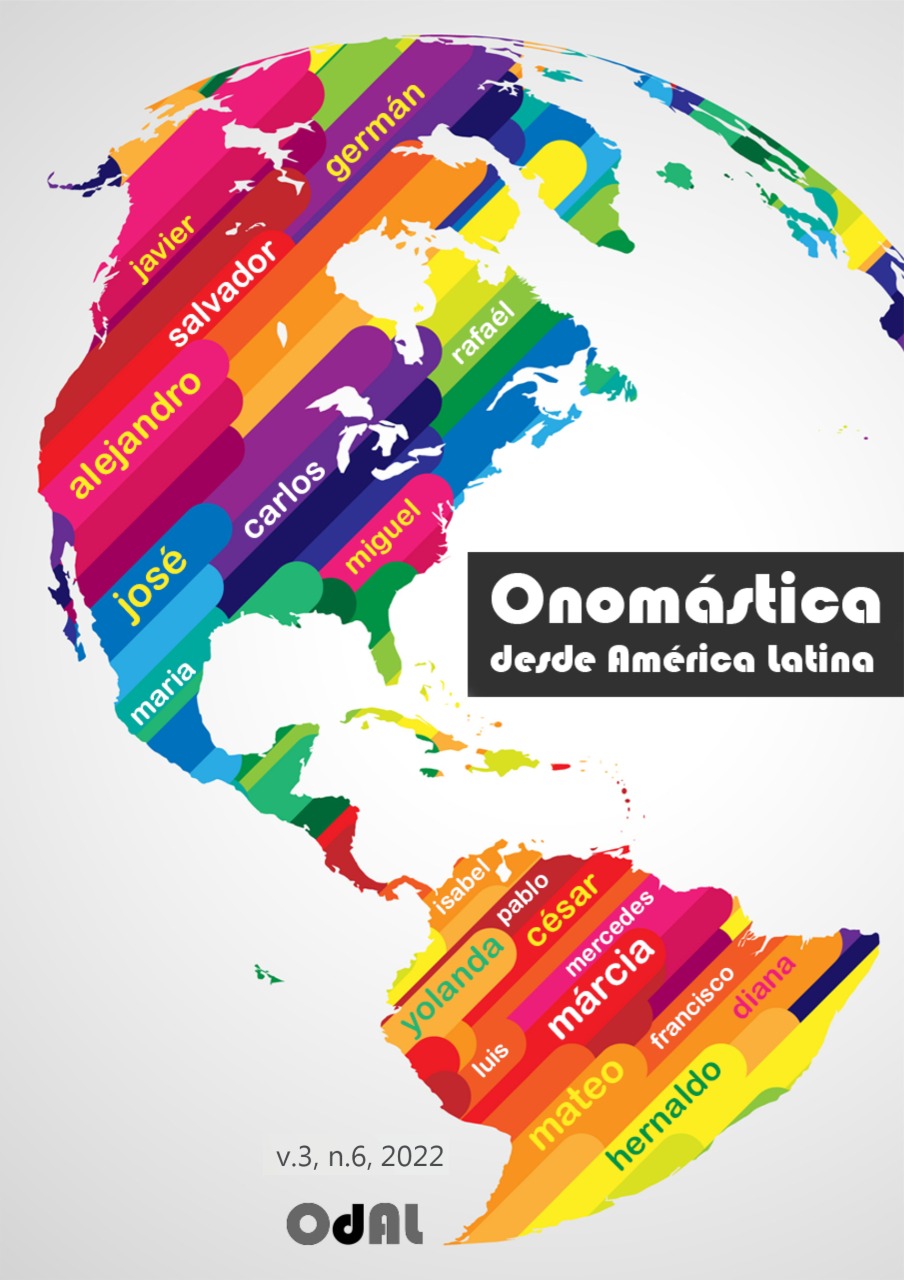What’s your sign? Personal Name Signs in Mexican Sign Language
DOI:
https://doi.org/10.48075/odal.v3i6.29930Palavras-chave:
Mexican sign language, name, deaf culture, deaf communityResumo
The use of a name/nickname/SIGN within the deaf community plays an important role, since it is a sign that identifies not only the deaf members of the same community, but also the listeners who are related to it. This sign is given by one of the members of the deaf community and implies both acceptance and identity within it. The creation of a personal sign in Mexican Sign Language responds to different ways of forming the name/nickname/sign that vary for each person. This research presents, first, the relevance of the proper name as a social element. Subsequently, the background on the study of personal signs in other sign languages. Finally, based on interviews with members of the deaf community, the three processes found for the formation of personal signs in Mexican Sign Language are shown: the assignment of signs by outstanding physical or behavioral traits; signs that have been inherited or that they share articulatory features in the family; and name sign change.
Referências
Barros, M. E. (2018). Taxonomia Antroponímica nas Línguas de Sinais -A Motivação dos Sinais-Nomes. RE_UNIR, 5(2), 40-62
Bézagu-Deluy, M. (1993). Personalities in the World of Deaf Mutes in 18th Century Paris. En R. Fischer y H. Lane (eds.). Looking Back. A reader on the History of Deaf Communities and their Sign Languages. Gallaudet University Press
Cortés-Miranda, H. (s.f.). El registro Civil a 150 años. Biblioteca Jurídica Virtual del Instituto de Investigaciones Jurídicas de la Universidad Nacional Autónoma de México. https://archivos.juridicas.unam.mx/www/bjv/libros/7/3067/4.pdf
Cruz Cruz J. C y Cruz-Aldrete M. (2013). Integración social del sordo en la Ciudad de México: enfoques médicos y pedagógicos (1867-1900). Cuicuilco, 20(56) 173-201.
Cruz-Aldrete, M. (2008). Gramática de la Lengua de Señas Mexicana. (Tesis de doctorado. Centro de Estudios Lingüísticos y Literarios. El Colegio de México). Puede consultarse en: http://elies.rediris.es/elies28/pdfs/Miroslava_Cruz_Aldrete_Tesis.pdf
Cruz-Aldrete, M. & Smith-Stark, Th. (2011). La morfología en la lengua de señas mexicana. En F. Arellanes, S. Ibañez Cerda, C. Sergio y C. Rojas Nieto (eds.). De morfología y temas asociados. Homenaje a Elizabeth Beniers Jacobs (pp. 289-334). Instituto de Investigaciones Filológicas. Universidad Nacional Autónoma de México.
de León Pasquel, M. (2005). La llegada del alma: lenguaje, infancia y socialización entre los mayas de Zinacantán. CIESAS, INAH.
Harlan Lane (1984) When the Mind Hears. A history of the Deaf. Penguin Books. ISBN: 0‐14‐022834‐9
Hedberg, T. (1994). Name signs in Swedish Sign Language: Their formation and use. En C. J. Erting, R. C. Johnson, D. L. Smith, B. D. Snider (eds.). The Deaf Way: perspectives from the International Conference on Deaf Culture (pp. 416-424). Gallaudet University Press.
Humphries, T. (2013). Schooling in American Sign Language: A paradigm shift from a deficit model to a bilingual model in deaf education. Berkeley Review of Education, 4(1), 7-33. https://www.researchgate.net/publication/325330234_Schooling_in_American_Sign_Language_A_paradigm_shift_from_a_deficit_model_to_a_bilingual_model_in_deaf_education
López Franco, Y. (2014). En torno al semantismo de los nombres propios. Entre debate y síntesis teórica. Revista Trama,10 (20), 69-81.
Meadow, K.P. (1977). Name Signs as Identity Symbols in the Deaf Community. Sign Language Studies 16, 237-246. doi:10.1353/sls.1977.0015.
Padden C. y T. Humphries. (2005). Inside deaf culture. Harvard University Press.
Rech, G. C. y Ferreira Sell, F. S. (2020). Os sinais de nome atribuídos no contexto acadêmico: uma abordagem Antroponomnástica. Onomástica Desde América Latina, 1(2), 67-82. https://doi.org/10.48075/odal.v1i2.25446
Rojas González, F. (1952). El Diosero. Fondo de Cultura Económica.
Seide, M, S. (2021). Proposta de definição interdisciplinar de nome próprio. Onomástica Desde América Latina, 2(4), 70-94. https://doi.org/10.48075/odal.v0i0.27562
Sousa, A. M., Silva de Oliveira, G. C., Gonçalves Filho, J. S., Quadros, R. M. (2020). Antroponímia em Lingua de Sinais: Os Sinais-Nome em Florianópolis-SC, Brasil. Revista Humanidades e Inovação, 7(26), 112-124.
Supalla, S. J. (1990). The Arbitrary Name Sign System in American Sign Language. Sign Language Studies, 67, 99-126.
Toparksoy, A. (2015). A linguistic study on the system of personal name signs in Turkish Sign Language (TID). (Master’s Thesis. Hacettepe University Graduate School of Social Sciences. Department of English Linguistics).
Downloads
Publicado
Como Citar
Edição
Seção
Licença
Copyright (c) 2022 Miroslava Cruz-Aldrete, Hann Bastian González Muciño

Este trabalho está licenciado sob uma licença Creative Commons Attribution-NonCommercial-ShareAlike 4.0 International License.
Aviso de Direito Autoral Creative Commons
Política para Periódicos de Acesso Livre
Autores que publicam nesta revista concordam com os seguintes termos:
1. Autores mantém os direitos autorais e concedem à revista o direito de primeira publicação, com o trabalho simultaneamente licenciado sob a Licença Creative Commons Attribution que permite o compartilhamento do trabalho com reconhecimento da autoria e publicação inicial nesta revista.
2. Autores têm autorização para assumir contratos adicionais separadamente, para distribuição não-exclusiva da versão do trabalho publicada nesta revista (ex.: publicar em repositório institucional ou como capítulo de livro), com reconhecimento de autoria e publicação inicial nesta revista.
3. Autores têm permissão e são estimulados a publicar e distribuir seu trabalho online (ex.: em repositórios institucionais ou na sua página pessoal) a qualquer ponto antes ou durante o processo editorial, já que isso pode gerar alterações produtivas, bem como aumentar o impacto e a citação do trabalho publicado (Veja O Efeito do Acesso Livre).
Licença Creative Commons
Esta obra está licenciada com uma Licença Creative Commons Atribuição-NãoComercial-CompartilhaIgual 4.0 Internacional, o que permite compartilhar, copiar, distribuir, exibir, reproduzir, a totalidade ou partes desde que não tenha objetivo comercial e sejam citados os autores e a fonte.

